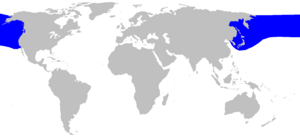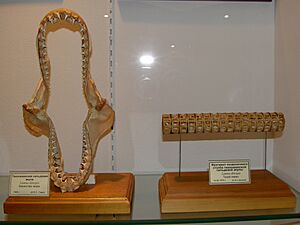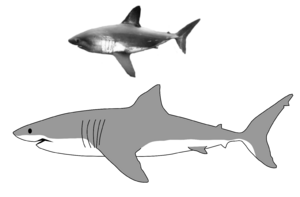Salmon shark facts for kids
Quick facts for kids Salmon shark |
|
|---|---|
 |
|
| Conservation status | |
| Scientific classification | |
| Genus: |
Lamna
|
| Species: |
ditropis
|
 |
|
| Range of the salmon shark | |
The salmon shark (Lamna ditropis) is a type of mackerel shark. You can find it in the northern Pacific Ocean. This shark is a top hunter, meaning it's at the very top of its food chain. It eats fish like salmon, sablefish, and herring, as well as squid.
One cool thing about the salmon shark is its special ability to keep its body warm, even in cold water. This is unusual for fish! Scientists are also curious about why there are different numbers of male and female salmon sharks in the eastern and western parts of the northern Pacific.
Contents
What Does a Salmon Shark Look Like?
Adult salmon sharks are mostly grey to black on top. Their belly is white and often has darker spots. Young salmon sharks look similar, but they usually don't have these spots.
They have a short, cone-shaped snout. Overall, they look a bit like a smaller version of a great white shark. Their eyes are set forward, which helps them see clearly and find their prey.
Salmon sharks usually grow to be about 200 to 260 centimeters (6.6 to 8.6 feet) long. They can weigh up to 220 kilograms (485 pounds). Male sharks tend to be a little smaller than females. While some people have reported seeing much larger salmon sharks, the biggest ones confirmed were about 3.0 meters (10 feet) long.
Salmon Shark Life
How Salmon Sharks Reproduce
Salmon sharks give birth to live young, usually two to six pups at a time. This is a special way of birth called ovoviviparous. Inside their mother, the baby sharks eat unfertilized eggs for food. This helps them grow strong before they are born.
Female salmon sharks are ready to have babies when they are about eight to ten years old. Males mature earlier, usually by age five. Scientists think that female sharks have babies every two years. Mating likely happens in late summer or early autumn. The babies grow inside the mother for about nine months.
How Salmon Sharks Stay Warm
Salmon sharks are one of the few fish species that can control their body temperature. This means they can stay warm even in very cold ocean water. They do this using a special system of blood vessels called "retia mirabilia," which means "wonderful nets" in Latin.
Imagine tiny pipes carrying warm blood from the shark's body very close to tiny pipes carrying cold blood from its gills. The warm blood gives its heat to the cold blood. This way, the shark loses very little heat to the cold water around it. This amazing system helps salmon sharks live in chilly waters where other fish might struggle.
Where Salmon Sharks Live
Salmon sharks are common in the northern Pacific Ocean, north of the equator. They live in waters near the coast but also further out in the ocean. Scientists have tracked them from very cold sub-Arctic waters to warmer subtropical areas.
They are found as far south as the Sea of Japan and as far north as Alaska. They are often seen in places like Prince William Sound in Alaska when salmon are migrating. Salmon sharks can dive very deep, sometimes over 600 meters (2,000 feet). However, they usually spend most of their time closer to the surface. While they often travel alone, or in small groups to hunt, sometimes they are seen swimming together in larger schools.
Differences in Regions
Scientists have noticed that the salmon shark populations in the eastern and western North Pacific are different. In the eastern Pacific, there are more female sharks. In the western Pacific, there are more male sharks. We don't know if these differences mean they are separate groups of sharks, or if the males and females just move to different areas as they grow up. Some people think that fishing practices in Japan might affect the number of males, as male salmon shark fins are sometimes used in traditional ways.
Salmon Sharks and People
There isn't a big fishing industry just for salmon sharks. However, they are sometimes caught by accident in nets meant for salmon. When this happens, they are usually thrown back into the ocean. Fishermen sometimes see salmon sharks as a problem because they can damage fishing gear and eat fish that fishermen want to catch.
Some people enjoy fishing for salmon sharks for sport, especially in Alaska and British Columbia. In Alaska, you can catch up to two salmon sharks per year. In British Columbia, you can catch one per day during certain times of the year.
The meat of the salmon shark can be eaten. In the Japanese city of Kesennuma, Miyagi, the heart of the salmon shark is considered a special food.
Even though salmon sharks are strong, there have been very few reports of them attacking humans. There are stories of divers seeing them or sharks bumping boats. However, it's hard to be sure if these were definitely salmon sharks.
Scientists have also looked into whether salmon sharks might be eating more Chinook salmon. This is because the number of Chinook salmon has gone down in some areas. Remote temperature tags on salmon have shown that some were swallowed by sharks, suggesting that salmon sharks might be part of the reason for the decline.
See also




